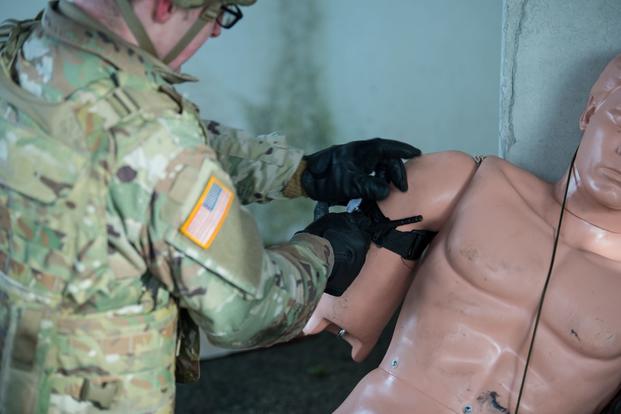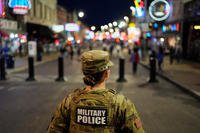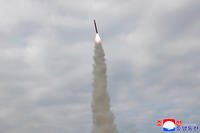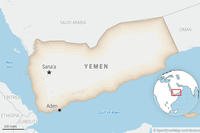When he was serving in Iraq as an Air Force emergency physician, Dr. Craig Goolsby saw some horrific injuries -- war wounds he could not imagine anyone surviving.
But many of his patients came in wearing tourniquets, simple band-and-bar contraptions put on by another soldier, sailor, Marine or airman, that stopped them from bleeding out.
"The military put together a program to teach soldiers what to do and to equip them with very simple, easy-to-use equipment," Goolsby said during a web broadcast Tuesday. "As soon as somebody was injured, the soldiers could take action that was life saving, even before a medical person or an ambulance could get to them. And that meant that they could get to the hospital alive."
The lessons learned in combat since 9/11, as well as the 2013 Boston Marathon bombing, inspired a nationwide "Stop the Bleed" campaign, launched by the White House in 2015, to teach more Americans how to apply tourniquets in emergency situations.
Read Next: Four Marines Injured in Kabul Airport Attack Remain at Walter Reed Nearly One Month Later
Taking the campaign a step further, the American Red Cross now is offering a course, "First Aid for Severe Trauma," or FAST, to high school students on tourniquet use, personal safety and communications in an emergency, based on the work of Goolsby and others.
According to Uniformed Services University of the Health Sciences, or USUHS, officials, traumatic injuries are the leading cause of death in the U.S. for people ages 1 to 44, including car accidents and falls that could result in severe wounds. USUHS is the U.S. military's medical school.
Gun violence also continues to be a threat: Each year, 3,000 children and teens are shot and killed and 15,000 shot and injured, and roughly 100 people die a day in the U.S. as the result of gunfire, according to Everytown for Gun Safety, a nonprofit that supports gun safety measures in state legislatures.
The 135-minute FAST course, which became available last month, is geared toward students grades 9-12, aiming to teach them skills that could save a life if they ever face an emergency situation.
During the course, they follow Red Cross tenets of "check, call, care:" Check that the situation is safe; call and effectively communicate with 9-1-1 dispatchers; and try to stem the bleeding before help arrives.
"It's so beneficial to teach these lessons directly to high schooler students," said Goolsby, now with the USUHS' National Center for Disaster Medicine and Public Health. "Not only are they willing to learn new skills and help others when needed, they also help spread this important information to friends, family and the next generation of Americans."
The course and materials are available for free to students under age 19. While it is offered online-only, an in-person skills session, during which students demonstrate they know how to apply direct pressure and a tourniquet on a dummy limb, is required to earn an official Red Cross FAST certification.
Prior to Sept. 11, 2001, just a few military units trained their personnel in tourniquet use, including Navy SEALs, the 75th Ranger Regiment, and Army and Air Force special operations units.
In 2004, however, a study at the U.S. Army Institute of Surgical Research found that 15% of battlefield deaths among special operations personnel were preventable, including a number that involved potentially stoppable hemorrhaging. Following the study, tourniquets began to be distributed to a much wider swath of the force.
After the Boston Marathon bombing, a campaign arose to place tourniquet and bleeding kits that contain gloves, a tourniquet, wound dressing, rolled gauze and scissors in ambulances -- those responding to the attack did not have tourniquets -- and in public spaces, such as office buildings and stores, alongside portable defibrillators.
Marie Manning, director of marketing for the American Red Cross' training services, said her organization is excited to offer this course, much of which is taught to adults in other first aid courses.
"Chance favors a prepared mind. That's my favorite saying. It's from the movie "Under Siege 2," but really, it's just the best," Manning said.
More information on the FAST course is available on the Red Cross website.
-- Patricia Kime can be reached at Patricia.Kime@Monster.com. Follow her on Twitter @patriciakime.
Related: Pentagon 9/11 Attack Survivors Grappled With Wounds that Defined an Era of War













